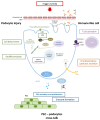Podocyte Injury in Lupus Nephritis
- PMID: 31470591
- PMCID: PMC6780135
- DOI: 10.3390/jcm8091340
Podocyte Injury in Lupus Nephritis
Abstract
Systemic lupus erythematosus (SLE) is characterized by a broad spectrum of renal lesions. In lupus glomerulonephritis, histological classifications are based on immune-complex (IC) deposits and hypercellularity lesions (mesangial and/or endocapillary) in the glomeruli. However, there is compelling evidence to suggest that glomerular epithelial cells, and podocytes in particular, are also involved in glomerular injury in patients with SLE. Podocytes now appear to be not only subject to collateral damage due to glomerular capillary lesions secondary to IC and inflammatory processes, but they are also a potential direct target in lupus nephritis. Improvements in our understanding of podocyte injury could improve the classification of lupus glomerulonephritis. Indeed, podocyte injury may be prominent in two major presentations: lupus podocytopathy and glomerular crescent formation, in which glomerular parietal epithelial cells play also a key role. We review here the contribution of podocyte impairment to different presentations of lupus nephritis, focusing on the podocyte signaling pathways involved in these lesions.
Keywords: crescent; lupus nephritis; lupus podocytopathy; nephrotic syndrome; podocytes.
Conflict of interest statement
The authors have no conflicts of interest to declare.
Figures
References
-
- Weening J.J., D’Agati V.D., Schwartz M.M., Seshan S.V., Alpers C.E., Appel G.B., Balow J.E., Bruijn J.A., Cook T., Ferrario F., et al. The classification of glomerulonephritis in systemic lupus erythematosus revisited. J. Am. Soc. Nephrol. JASN. 2004;15:241–250. doi: 10.1097/01.ASN.0000108969.21691.5D. - DOI - PubMed
Publication types
LinkOut - more resources
Full Text Sources


